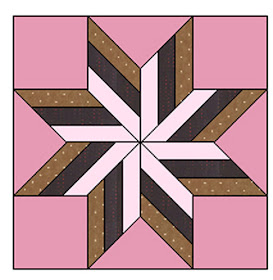Yankee Notions #7, Liberty Star by Becky Brown
America, the Land of Liberty, has a checkered history with the word. As Samuel Johnson (late-18th-century-London's version of Dorothy Parker) asked:
"How is it that we hear the loudest yelps for liberty among the drivers of negroes?"
Johnson was complaining about the entire 13 colonies during our Revolution. As the decades went by regional differences in the concept of "liberty" continued to be a paradox and regional differences about the word's meaning widened.
UPDATE: I added Dorry Emmer's blocks.
Harriet Beecher Stowe
"Liberty!---electric word! What is it?"
Uncle Tom's Cabin or Life Among the Lowly
The Genius of America Encouraging the Emancipation of the Blacks
1792. Library Company of Philadelphia
1792. Library Company of Philadelphia
David Hackett Fischer in his book Liberty and Freedom: A Visual History of America's Founding Ideas discusses the many concepts of these words, noting the sectional "conflict between irreconcilable visions of liberty and freedom. Both sides used the same words, but in different combinations with distinct meaning....Confederate leaders always insisted that they were fighting for liberty and freedom ...a condition of independence and autonomy...The Confederate idea of liberty was not for everyone. The master class had many liberties. Slaves had none."
Southerners had no problem using the words liberty and slave in the same sentence.
Alexander Stephens (1812-1883) of Georgia
Confederate Vice-President Alexander Stephens believed the sectional conflict was over federal Constitutional ideas of liberty:
"Those ideas, however, were fundamentally wrong. They rested upon the assumption of the equality of races. This was an error. It was a sandy foundation, and the government built upon it fell when the 'storm came and the wind blew.' "
"The readers of these volumes will find in them, one mass of gross misrepresentation and ridiculous blundering. The authoress is so ignorant of Southern life and slave institutions, that she does not know how very far she leaves behind her, the track of probability." Louisa Cheves McCord.
"A dream caused by the perusal of Mrs. H. Beecher Stowe's
popular work Uncle Tom's Cabin" by Kentucky lithographer C.R. Milne, 1853
Library of Congress
Stowe is being pulled into a cave, the Underground Railway,
by satanic demons holding her book.
"We can imagine that she writes a big, scrawling hand, with the letters all backwards, avoiding neatness with pains-taking precision -- her voice is probably harsh, her attitude imposing, and she will, or does, wear her own grey hair in the mother-of-a-nation style."
According to Fischer Yankee Notions of Liberty included, "community self-government, which could impose substantial restrictions on individual freedom." Many Southerners saw any restrictions as an unacceptable compromise.
Liberty Star by Denniele Bohannon
The Block
Crib quilt from the mid-20th-century.
BlockBase #3748
In 1932 quilt columnist Eveline Foland of the Kansas City Star suggested red, white and blue for Liberty Star.
12" Block
A - Cut 4 squares 4".
B - Cut 1 square 6-1/4". Cut into 4 triangles with 2 cuts.
C - Cut 24 strips (3 different shades) 1-3/8" wide for the stripes. Cut these at 45 degree angles with a base of 4-1/4".
18" Block
A - Cut 4 squares 5-3/ 4".B - Cut 1 square 8-3/4". Cut into 4 triangles with 2 cuts.
C - Cut 24 strips (3 different shades) 1-3/4" wide for the stripes. Cut these at 45 degree angles with a base of 6".
OR
Use striped fabric---pieced or printed--- and cut this out like a regular diamond star with 8 parallelograms. Piece C would then be....
12"
Cut strips 3" wide and cut at 45 degree angles with a base of 4-1/4".
18"
Cut strips 4-1/4" wide and cut at 45 degree angles with a base of 6".
QuiltFolk magazine will show you how to make the star of pieced strips...
https://www.quiltfolk.com/wp-content/uploads/woocommerce_uploads/qf-pattern-005-November-2018.pdf?_ke=eyJrbF9lbWFpbCI6ICJqaWxsZXJuNTdAeWFob28uY29tIiwgImtsX2NvbXBhbnlfaWQiOiAiUUU0N0FqIn0%3D
In 1855 The Liberator (a Massachusetts anti-slavery newspaper) wrote of the "treasonable motto---Liberty first and Union afterwords."
These reflections on regional concepts of personal liberty versus the good of the community may help us understand the sectionalism in mask-wearing during a pandemic.
See a preview of David Hackett Fischer's Liberty and Freedom: A Visual History of America's Founding Ideas here:
https://books.google.com/books?id=uc8KP_QtW-sC&printsec=frontcover&source=gbs_ge_summary_r&cad=0#v=onepage&q&f=false
Read more about Louisa Cheves McCord, the harsh Southern voice advocating the slave system here:
https://civilwarquilts.blogspot.com/2020/03/cassandras-circle-3-louisa-cheves.html
QuiltFolk magazine will show you how to make the star of pieced strips...
which is what Becky did.
https://www.quiltfolk.com/wp-content/uploads/woocommerce_uploads/qf-pattern-005-November-2018.pdf?_ke=eyJrbF9lbWFpbCI6ICJqaWxsZXJuNTdAeWFob28uY29tIiwgImtsX2NvbXBhbnlfaWQiOiAiUUU0N0FqIn0%3D
Liberty Star by Denniele Bohannon, 12" version
Vintage Liberty Star
This Month's Tangible Yankee Notion:
Manufactured Pincushions
Homemade pincushion
Fashioning pincushions was a common needlework project but the Yankee peddler might carry
manufactured pincushions.
A little luxury...
Silver baubles that made lovely gifts
or practical tools.
Most of these metal pincushions date to the turn
of the 20th century but they're such fun to look at we'll admit the anachronism.
And fun to collect.
Detail of Persis Bradbury's 1864 wool table cover
pictured in Woodard & Greenstein's
Crib Quilts & Other Small Wonders.
See a post on this piece here:
And the corrections here:
Becky Brown's Blocks 1-7
https://books.google.com/books?id=uc8KP_QtW-sC&printsec=frontcover&source=gbs_ge_summary_r&cad=0#v=onepage&q&f=false
Read more about Louisa Cheves McCord, the harsh Southern voice advocating the slave system here:
https://civilwarquilts.blogspot.com/2020/03/cassandras-circle-3-louisa-cheves.html
Liberty Star #7 Dorry Emmer





































Thank you for this historical context. It has shown me see our situation in the long view, and for some reason this is helpful. I also appreciate your even tone throughout. Of course, the star is wonderful, and the quilts are beautiful.
ReplyDeleteIt's really helped me to understand that there are big cultural differences in this big country. People are raised with very different values.
ReplyDeleteBarbara, did you know that Harriet Beecher Stowe had a winter home in the south starting in 1867? She had a home in Mandarin, Florida, now part of Jacksonville, where my mother's family lived. She was known as a "kind and famous lady" according to a book I have. She helped to found Episcopal churches and a school, among other things.
ReplyDeleteSo much great information packed into the post! Thanks!!
ReplyDelete